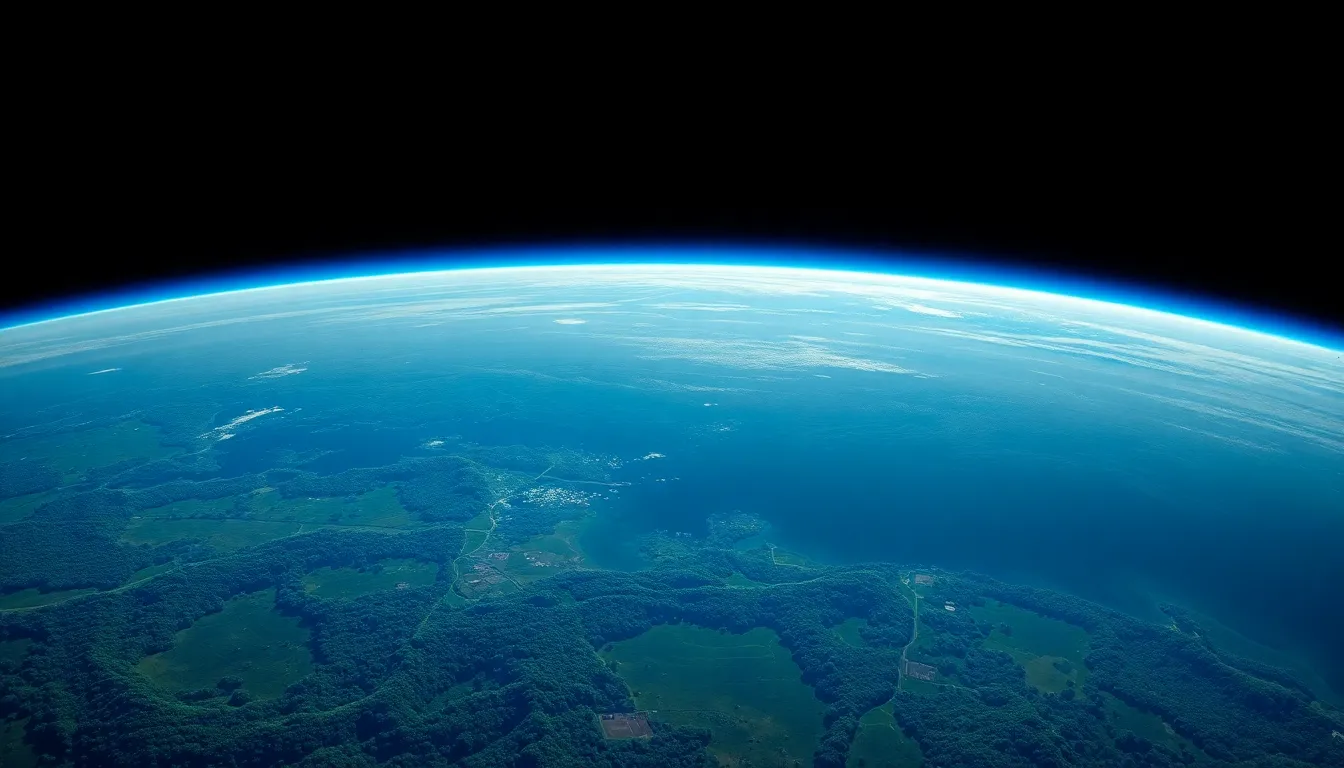Table of Contents
ToggleEver gazed up at the night sky and wondered just how far it is to space? Spoiler alert: it’s not as far as your last road trip! In fact, space is often considered to begin at the Kármán line, a mere 62 miles up. That’s about the same distance as a long drive to Grandma’s house—except there’s no traffic and definitely no speed limits!
Understanding Space
Space begins at the Kármán line, situated 62 miles above the Earth’s surface. This standard demarcation is significant in aerospace and aviation contexts. Numerous organizations, including NASA, recognize this boundary when defining space.
Various altitudes classify different layers of the atmosphere, which extend from the surface to the edge of space. The troposphere, where weather occurs, sits closest to Earth’s surface, ranging from 0 to about 7 to 12 miles. Above it lies the stratosphere, spanning from about 7 to 30 miles, where commercial airplanes typically operate.
The mesosphere extends from 30 to 50 miles, hosting meteors as they burn upon entry. The thermosphere, reaching from 50 to 600 miles, includes the International Space Station’s orbit at approximately 250 miles. Above this layer lies the exosphere, which gradually merges with outer space, marking the transition from atmospheric to cosmic environments.
Understanding these layers enhances awareness of what constitutes space. The perception of distance can be misleading; it’s remarkable to note that traveling to space is feasible within a short flight time. For aspiring astronauts, the journey encompasses not just physical distance, but also preparation for the unique environment in space.
Some space missions aim to reach altitudes higher than the Kármán line, showcasing technology’s advancements. Future aspirations include commercial space travel, allowing civilians to experience the thrill of heading to space. As technology evolves, access to the realm beyond Earth becomes increasingly attainable.
The Kármán Line

The Kármán line marks the boundary of space, positioned at 62 miles above the Earth’s surface. Recognized internationally, this line serves as a pivotal reference for space agencies and defines where Earth’s atmosphere transitions into outer space.
Definition and Significance
The Kármán line signifies the altitude where atmospheric conditions become insufficient for conventional aircraft to achieve lift. As altitude increases, air density decreases, causing aircraft to rely on speed rather than lift from their wings. This boundary is essential for distinguishing between aeronautics and astronautics, allowing scientists to categorize different flight regimes. Various organizations, including NASA and the Fédération Aéronautique Internationale, widely accept this designation as the official point at which space begins. Understanding the Kármán line enhances comprehension of space travel and its technical challenges.
Measurements and Milestones
Establishing the Kármán line involved extensive research and calculations by Hungarian-American engineer Theodore von Kármán. Its determination dates back to the 1950s when he identified the altitude’s significance for flight. Milestones related to this landmark include the first manned flight beyond the line, achieved by Yuri Gagarin in 1961, and subsequent missions that confirmed its validity. The rapid advancement in technology has led to numerous spaceflights targeting the Kármán line, making the aspiration for commercial space tourism a growing reality. Each successful launch reinforces the ongoing quest to conquer the boundaries of space.
Layers of the Atmosphere
Understanding the layers of the atmosphere clarifies the boundary to space. Each layer plays a distinct role in Earth’s environment.
Troposphere to Exosphere
The troposphere sits closest to Earth’s surface and extends up to 8 to 15 miles high. This layer contains most weather phenomena and the majority of the atmosphere’s mass. Above the troposphere lies the stratosphere, reaching about 30 miles up, where commercial jets typically fly. The mesosphere spans from 30 to 50 miles and is home to the coldest temperatures. It is above this layer that the thermosphere begins, extending up to 600 miles, where temperatures rise significantly due to solar radiation. Finally, the exosphere, which transitions into outer space, stretches from about 600 miles to 6,200 miles. Understanding these layers illustrates how extensive the atmosphere is before reaching the boundary of space.
Transition to Space
Transitioning to space occurs at the Kármán line, set at 62 miles above Earth. This altitude signifies a marked change in atmospheric density. Conventional aircraft can’t achieve lift beyond this point despite the existence of some atmospheric remnants. Spacecraft, designed to operate in the vacuum of space, become necessary as one approaches this boundary. Penetrating the exosphere, any vehicle experiences a significant reduction in air pressure. The contrast between the layers and the void of space highlights the challenges faced by spacecraft. Therefore, recognizing this transition reshapes understanding of what it takes to reach beyond Earth’s atmosphere.
Human Spaceflight
Human spaceflight has made remarkable strides since its inception. Astronauts now travel beyond the Kármán line, marking a significant achievement in exploration.
Altitudes Achieved
Various missions have reached altitudes significantly higher than 62 miles. NASA’s Space Shuttle routinely operated around 200 miles in low Earth orbit. The International Space Station orbits at approximately 250 miles, allowing continuous human presence in space since 2000. Recent developments in commercial spaceflight also see suborbital flights reaching about 62 miles, enabling civilian participation in space travel. Companies like Blue Origin and Virgin Galactic are pioneering this industry, bringing accessibility to those eager to experience space.
Spacecraft Operations
Spacecraft operations involve complex systems designed for specific altitudes. Each mission employs multiple stages, optimizing efficiency as it ascends. Crew modules must endure extreme conditions during launch and reentry, requiring specialized materials and engineering. Launch vehicles such as SpaceX’s Falcon 9 are engineered to transport payloads to various destinations, including the International Space Station. Regular missions illustrate an effective collaboration among national and commercial entities, enhancing the future of human spaceflight.
Scientific Implications
Space exploration significantly impacts various fields, including physics, biology, and environmental science. Researchers gather data from experiments conducted beyond the Kármán line, helping to understand the effects of microgravity on living organisms. Investigating phenomena like cosmic radiation and its implications aids in developing better protective measures for astronauts during long-duration missions. Data collection from experiments in space opens doors for technological advancements, enhancing materials used in everyday applications on Earth.
Educational perspectives benefit greatly from the ongoing exploration of space. Incorporating information about atmospheric layers and space travel into curricula fosters interest in science and technology among students. Engaging lessons centered on real-world applications emphasize the importance of scientific inquiry. Programs connecting classrooms with space missions inspire students to pursue careers in STEM fields. Collaborative initiatives between educational institutions and space agencies encourage practical learning experiences, igniting curiosity about the universe.
The journey to space isn’t as distant as many might believe. With the Kármán line marking the beginning of this vast frontier, advancements in technology are making space travel more accessible than ever. As commercial spaceflight continues to evolve, the dream of experiencing weightlessness and seeing Earth from above is becoming a reality for civilians.
Understanding the atmospheric layers and the significance of the Kármán line not only enriches knowledge but also sparks interest in the fields of science and engineering. The ongoing exploration of space holds the promise of new discoveries that could reshape humanity’s future and inspire the next generation of explorers.





